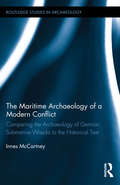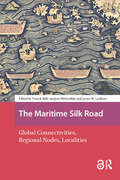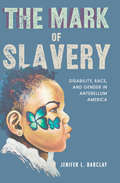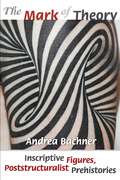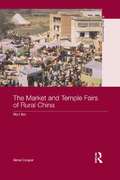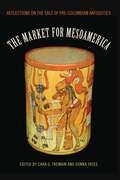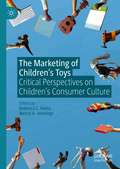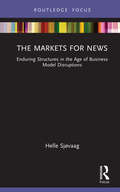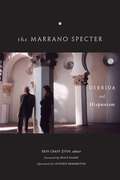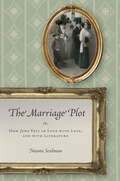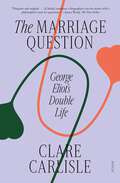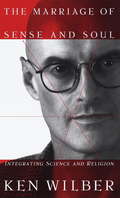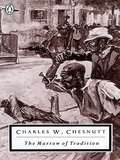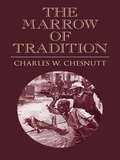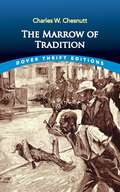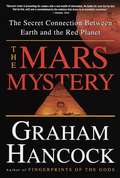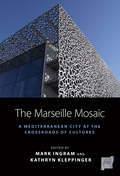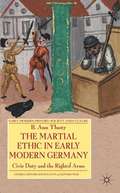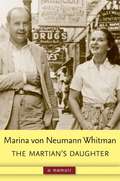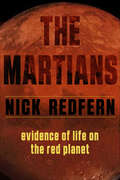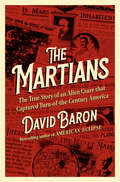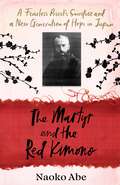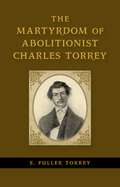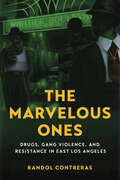- Table View
- List View
The Maritime Archaeology of a Modern Conflict: Comparing the Archaeology of German Submarine Wrecks to the Historical Text (Routledge Studies in Archaeology)
by Innes McCartneyOver the last 30 years, hydrographical marine surveys in the English Channel helped uncover the potential wreck sites of German submarines, or U-boats, sunk during the conflicts of World War I and World War II. Through a series of systemic dives, nautical archaeologist and historian Innes McCartney surveyed and recorded these wrecks, discovering that the distribution and number of wrecks conflicted with the published histories of U-boat losses. Of all the U-boat war losses in the Channel, McCartney found that some 41% were heretofore unaccounted for in the historical literature of World War I and World War II. This book reconciles these inaccuracies with the archaeological record by presenting case studies of a number of dives conducted in the English Channel. Using empirical evidence, this book investigates possible reasons historical inconsistencies persist and what Allied operational and intelligence-based processes caused them to occur in the first place. This book will be of interest to scholars and researchers in the fields of nautical archaeology and naval history, as well as wreck explorers.
The Maritime Silk Road: Global Connectivities, Regional Nodes, Localities (Asian Borderlands)
by Franck Billé Sanjyot Mehendale James W. LanktonThe Maritime Silk Road foregrounds the numerous networks that have been woven across oceanic geographies, tying world regions together often far more extensively than land-based routes. On the strength of the new data which has emerged in the last two decades in the form of archaeological findings, as well as new techniques such as GIS modelling, the authors collectively demonstrate the existence of a very early global maritime trade. From architecture to cuisine, and language to clothing, evidence points to early connections both within Asia and between Asia and other continents—well before European explorations of the Global South. The human stories presented here offer insights into both the extent and limits of this global exchange, showing how goods and people travelled vast distances, how they were embedded in regional networks, and how local cultures were shaped as a result.
The Mark of Slavery: Disability, Race, and Gender in Antebellum America
by Jenifer L. BarclayExploring the disability history of slavery Time and again, antebellum Americans justified slavery and white supremacy by linking blackness to disability, defectiveness, and dependency. Jenifer L. Barclay examines the ubiquitous narratives that depicted black people with disabilities as pitiable, monstrous, or comical, narratives used not only to defend slavery but argue against it. As she shows, this relationship between ableism and racism impacted racial identities during the antebellum period and played an overlooked role in shaping American history afterward. Barclay also illuminates the everyday lives of the ten percent of enslaved people who lived with disabilities. Devalued by slaveholders as unsound and therefore worthless, these individuals nonetheless carved out an unusual autonomy. Their roles as caregivers, healers, and keepers of memory made them esteemed within their own communities and celebrated figures in song and folklore. Prescient in its analysis and rich in detail, The Mark of Slavery is a powerful addition to the intertwined histories of disability, slavery, and race.
The Mark of Theory: Inscriptive Figures, Poststructuralist Prehistories
by Andrea BachnerWhat imaginaries, tropes, and media have shaped how we theorize? The Mark of Theory argues that inscription constitutes one of the master metaphors of contemporary theory.As a trope that draws on a wide array of practices of marking, from tattooing to circumcision, from photographic imprints and phonographic grooves to marks on a page, inscription provides an imaginary that orients and irritates theoretical thought. Tracing inscriptive imaginaries from the late nineteenth century to today, The Mark of Theory offers a wide-ranging conceptual genealogy of contemporary thought. Navigating poststructuralism’s attention to figurative language as well as media theory’s attention to objects, phenomena, and practices of mediation, the book works through core questions for how we theorize. Across a range of disciplines and scholarly conversations—from literature and media to anthropology, race and gender, art, psychoanalysis, sound, and ultimately ethics—sites of inscription come to constitute the past legacy of a thought to come, a prehistory of our current moment.In focusing on materiality and mediation The Mark of Theory shows how inscriptive practices shape conceptual thought, as well as political and ethical choices. By contextualizing the fraught relationship between materiality and signification, The Mark of Theory lays the ground for a politics of theory that begins there where theory and politics are no longer conflated.
The Market and Temple Fairs of Rural China: Red Fire (Asia's Transformations)
by Gene CooperDuring the early communist period of the 1950s, temple fairs in China were both suppressed and secularized. Temples were closed down by the secular regime and their activities classified as feudal superstition and this process only intensified during the Cultural Revolution when even the surviving secular fairs, devoted exclusively to trade with no religious content of any kind, were suppressed. However, once China embarked on its path of free market reform and openness, secular commodity exchange fairs were again authorized, and sometimes encouraged in the name of political economy as a means of stimulating rural commodity circulation and commerce. This book reveals how once these secular "temple-less temple fairs" were in place, they came to serve not only as venues for the proliferation of a great variety of popular cultural performance genres, but also as sites where a revival or recycling of popular religious symbols, already underway in many parts of China, found familiar and fertile ground in which to spread. Taking this shift in the Chinese state’s attitudes and policy towards temple fairs as its starting point, The Market and Temple Fairs of Rural China shows how state-led economic reforms in the early 1980s created a revival in secular commodity exchange fairs, which were granted both the geographic and metaphoric space to function. In turn, this book presents a comprehensive analysis of the temple fair phenomenon, examining its economic, popular cultural, popular religious and political dimensions and demonstrates the multifaceted significance of the fairs which have played a crucial role in expanding the boundaries of contemporary acceptable popular discourse and expression. Based upon extensive fieldwork, this unique book will be of great interest to students and scholars of Chinese religion, Chinese culture, Chinese history and anthropology.
The Market for Mesoamerica: Reflections on the Sale of Pre-Columbian Antiquities (Maya Studies)
by Donna Yates Cara G. TremainDiscussions on the illicit trafficking of precolonial cultural heritage items Pre-Columbian artifacts are among the most popular items on the international antiquities market, yet it is becoming increasingly difficult to monitor these items as public, private, and digital sales proliferate. This timely volume explores past, current, and future policies and trends concerning the sales and illicit movement of artifacts from Mesoamerica to museums and private collections. Informed by the fields of anthropology, economics, law, and criminology, contributors critically analyze practices of research and collecting in Central American countries. They assess the circulation of looted and forged artifacts on the art market and in museums and examine government and institutional policies aimed at fighting trafficking. They also ask if and how scholars can use materials removed from their context to interpret the past. The theft of cultural heritage items from their places of origin is a topic of intense contemporary discussion, and The Market for Mesoamerica updates our knowledge of this issue by presenting undocumented and illicit antiquities within a regional and global context. Through discussion of transparency, accountability, and ethical practice, this volume ultimately considers how antiquities can be protected and studied through effective policy and professional practice. Contributors: Cara G. Tremain | Donna Yates | Martin Berger | Allison Davis | James Doyle | Rosemary Joyce | Nancy L. Kelker | Guido Krempel | Christina Luke | Sofia Paredes Maury | Adam Sellen A volume in the series Maya Studies, edited by Diane Z. Chase and Arlen F. Chase
The Marketing of Children’s Toys: Critical Perspectives on Children’s Consumer Culture
by Rebecca C. Hains Nancy A. JenningsThis book offers rich critical perspectives on the marketing of a variety of toys, brands, and product categories. Topics include marketing undertaken by specific children’s toy brands such as American Girl, Barbie, Disney, GoldieBlox, Fisher-Price, and LEGO, and marketing trends characterizing broader toy categories such as on-trend grotesque toys; toy firearms; minimalist toys; toyetics; toys meant to offer diverse representation; STEM toys; and unboxing videos. Toy marketing warrants a sustained scholarly critique because of toys’ cultural significance and their roles in children’s lives, as well as the industry’s economic importance. Discourses surrounding toys—including who certain toys are meant for and what various toys and brands can signify about their owners’ identities—have implications for our understandings of adults’ expectations of children and of broader societal norms into which children are being socialized.
The Markets for News: Enduring Structures in the Age of Business Model Disruptions (Disruptions)
by Helle SjøvaagIn the face of ongoing digitisation, The Markets for News examines how certain established economic features of the news industry have persisted and what makes them such stable frameworks for journalistic organisations. Drawing on an analysis of Scandinavian news industries, this text revises journalism’s economic foundations in the context of the algorithmically driven platform economy. Exploration of features such as journalism’s two-sided market model, the network effect of platforms, and chain ownership, leads to a discussion about how journalism faces disruption from the introduction of artificial intelligence in the production, dissemination, and sale of news. As journalism undergoes transformations due to revenue losses, this book recognises a return to certain enduring features of journalism’s organisational form, in particular the chain ownership form, that enables scale in adapting to platform logics and economics. This text serves as a basis for a theoretical discussion about strategic media management and critical political economy in the age of digital disruption. This is an insightful book for academics and researchers in the fields of journalism, media industries, media policy and, communication studies.
The Marrano Specter: Derrida and Hispanism
by Erin Graff ZivinThe Marrano Specter pursues the reciprocal influence between Jacques Derrida and Hispanism. On the one hand, Derrida’s work has engendered a robust conversation among philosophers and critics in Spain and Latin America, where his work circulates in excellent translation, and where many of the terms and problems he addresses take on a distinctive meaning: nationalism and cosmopolitanism; spectrality and hauntology; the relation of subjectivity and truth; the university; disciplinarity; institutionality.Perhaps more remarkably, the influence is in a profound sense reciprocal: across his writings, Derrida grapples with the theme of marranismo, the phenomenon of Sephardic crypto-Judaism. Derrida’s marranismo is a means of taking apart traditional accounts of identity; a way for Derrida to reflect on the status of the secret; a philosophical nexus where language, nationalism, and truth-telling meet and clash in productive ways; and a way of elaborating a critique of modern biopolitics. It is much more than a simple marker of his work’s Hispanic identity, but it is also, and irreducibly, that.The essays collected in The Marrano Specter cut across the grain of traditional Hispanism, but also of the humanistic disciplines broadly conceived. Their vantage point—the theoretical, philosophically inflected critique of disciplinary practices—poses uncomfortable, often unfamiliar questions for both hispanophone studies and the broader theoretical humanities.
The Marriage Plot: Or, How Jews Fell in Love with Love, and with Literature
by Naomi SeidmanFor nineteenth-century Eastern European Jews, modernization entailed the abandonment of arranged marriage in favor of the "love match." Romantic novels taught Jewish readers the rules of romance and the choreography of courtship. But because these new conceptions of romance were rooted in the Christian and chivalric traditions, the Jewish embrace of "the love religion" was always partial. In The Marriage Plot, Naomi Seidman considers the evolution of Jewish love and marriage though the literature that provided Jews with a sentimental education, highlighting a persistent ambivalence in the Jewish adoption of European romantic ideologies. Nineteenth-century Hebrew and Yiddish literature tempered romantic love with the claims of family and community, and treated the rules of gender complementarity as comedic fodder. Twentieth-century Jewish writers turned back to tradition, finding pleasures in matchmaking, intergenerational ties, and sexual segregation. In the modern Jewish voices of Sigmund Freud, Erica Jong, Philip Roth, and Tony Kushner, the Jewish heretical challenge to the European romantic sublime has become the central sexual ideology of our time.
The Marriage Question: George Eliot's Double Life
by Clare CarlisleNamed one of the ten Best Reviewed Nonfiction Books of 2023 by Literary Hub A startling new portrait of George Eliot, the beloved novelist and a rare philosophical mind who explored the complexities of marriage.In her mid-thirties, Marian Evans transformed herself into George Eliot—an author celebrated for her genius as soon as she published her debut novel. During those years she also found her life partner, George Lewes—writer, philosopher, and married father of three. After “eloping” to Berlin in 1854, they lived together for twenty-four years: Eliot asked people to call her "Mrs Lewes" and dedicated each novel to her "Husband." Though they could not legally marry, she felt herself initiated into the "great experience" of marriage—"this double life, which helps me to feel and think with double strength." The relationship scandalized her contemporaries yet she grew immeasurably within it. Living at once inside and outside marriage, Eliot could experience this form of life—so familiar yet also so perplexing—from both sides. In The Marriage Question, Clare Carlisle reveals Eliot to be not only a great artist but also a brilliant philosopher who probes the tensions and complexities of a shared life. Through the immense ambition and dark marriage plots of her novels, we see Eliot wrestling—in art and in life—with themes of desire and sacrifice, motherhood and creativity, trust and disillusion, destiny and chance. Carlisle's searching new biography explores how marriage questions grow and change, and joins Eliot in her struggle to marry thought and feeling.Includes black-and-white images
The Marriage of Sense and Soul: Integrating Science and Religion
by Ken WilberThere is arguably no more critical and pressing topic than the relation of science and religion in the modern world. Science has given us the methods for discovering truth, while religion remains the single greatest force for generating meaning. Yet the two are seen as mutually exclusive, with wrenching consequences for humanity. In The Marriage of Sense and Soul, one of today's most important philosophers brilliantly articulates how we might begin to think about science and religion in ways that allow for their reconciliation and union, on terms that will be acceptable to both camps. Ken Wilber is widely acclaimed as the foremost thinker in integrating Western psychology and the Eastern spiritual traditions. His many books have reached across disciplines and synthesized the teachings of religion, psychology, physics, mysticism, sociology, and anthropology, earning him a devoted international following. The Marriage of Sense and Soul is his most accessible work yet, aimed at guiding a general audience to the mutual accord between the spiritual, subjective world of ancient wisdom and the objective, empirical world of modern knowledge. Wilber clearly and succinctly explores the schism between science and religion, and the impact of this "philosophical Cold War" on the fate of humanity. He systematically reviews previous attempts at integration, explaining why romantic, idealistic, and postmodern theories failed. And he demonstrates how science is compatible with certain deep features common to all of the world's major religious traditions. In pointing the way to a union between truth and meaning, Ken Wilber has created an elegant and accessible book that is breathtaking in its scope.From the Hardcover edition.
The Marrow of Tradition
by Charles W. Chesnutt"Stay here beside her, major. I shall not he needed for an hour yet. Meanwhile I'll go downstairs and snatch a bit of sleep, or talk to oldJane. "The night was hot and sultry. Though the windows of the chamber were wide open, and the muslin curtains looped back, not a breath of air was stirring. Only the shrill chirp of the cicada and the muffled croaking of the frogs in some distant marsh broke the night silence. The heavy scent of magnolias, overpowering even the strong smell of drugs in the sickroom, suggested death and funeral wreaths, sorrow and tears, the long home, the last sleep. The major shivered with apprehension as the slender hand which he held in his own contracted nervously and in a spasm of pain clutched his fingers with a viselike grip. Major Carteret, though dressed in brown linen, had thrown off his coat for greater comfort. The stifling heat, in spite of the palm-leaf fan which he plied mechanically, was scarcely less oppressive than his own thoughts. Long ago, while yet a mere boy in years, he had come back from Appomattox to find his family, one of the oldest and proudest in the state, hopelessly impoverished by the war,-even their ancestral home swallowed up in the common ruin. His elder brother had sacrificed his life on the bloody altar of the lost cause, and his father, broken and chagrined, died not many years later, leaving the major the last of his line. He had tried in various pursuits to gain a foothold in the new life, but with indifferent success until he won the hand of Olivia Merkell, whom he had seen grow from a small girl to glorious womanhood. With her money he had founded the Morning Chronicle, which he had made the leading organ of his party and the most influential paper in the State. The fine old house in which they lived was hers. In this very room she had first drawn the breath of life; it had been their nuptial chamber; and here, too, within a few hours, she might die, for it seemed impossible that one could long endure such frightful agony and live.
The Marrow of Tradition
by Charles W. ChesnuttA landmark in the history of African-American fiction, this gripping 1901 novel was among the first literary challenges to racial stereotypes. Its tragic history of two families unfolds against the backdrop of the post-Reconstruction South and climaxes with a race riot based on an actual 1898 incident. The author relied upon eyewitness accounts of the riot to create an authentic setting and mood, and his sensitive artistry transcends a simple re-telling of the facts with a dramatic rendering of the conflict between racism and social justice. Unabridged republication of the classic 1901 edition.
The Marrow of Tradition: Large Print (Dover Thrift Editions)
by Charles W. ChesnuttIn this landmark tale, one of the great American novelists exposed the harsh dimensions of Southern prejudice during post–Reconstruction era. Charles W. Chesnutt traces the intertwined lives of two prominent families: one headed by a newspaper editor and flagrant white supremacist; the other by the founder of a hospital for African Americans, whose biracial wife is the unacknowledged half-sister of the editor's wife. Their personal dramas unfold amid an atmosphere of public hysteria that erupts in a massacre — one based on an actual incident. The 1898 race riot of Wilmington, North Carolina, left a considerable number of African Americans dead and expelled thousands more from their homes. Chesnutt drew upon survivors' accounts, including those of members of his own family, for an authentic retelling of the facts. His powerful and passionate exploration of how miscegenation, social rank, and the concept of white supremacy gave rise to Jim Crow laws provides an insightful analysis of racial conflict at the turn of the twentieth century.
The Marrying Kind?: Debating Same-Sex Marriage within the Lesbian and Gay Movement
by Mary Bernstein and Verta TaylorAs the fight for same-sex marriage rages across the United States and lesbian and gay couples rush to marriage license counters, the goal of marriage is still fiercely questioned within the LGBT movement. Rarely has an objective so central to a social movement&’s political agenda been so controversial within the movement itself. While antigay forces work to restrict marriage to one man and one woman, lesbian and gay activists are passionately arguing about the desirability, viability, and social consequences of same-sex marriage. The Marrying Kind? is the first book to draw on empirical research to examine these debates and how they are affecting marriage equality campaigns. The essays in this volume analyze the rhetoric, strategies, and makeup of the LGBT social movement organizations pushing for same-sex marriage, and address the dire predictions of some LGBT commentators that same-sex marriage will spell the end of queer identity and community. Case studies from California, Connecticut, Massachusetts, New Jersey, Oklahoma, Vermont, and Canada illuminate the complicated politics of same-sex marriage, making clear that the current disagreements among LGBT activists over whether marriage is conforming or transformative are far too simplistic. Instead, the impact of the marriage equality movement is complex and often contradictory, neither fully assimilationist nor fully oppositional. Contributors: Ellen Ann Andersen, U of Vermont; Mary C. Burke, U of Vermont; Adam Isaiah Green, U of Toronto; Melanie Heath, McMaster U, Ontario; Kathleen E. Hull, U of Minnesota; Katrina Kimport, U of California, San Francisco; Jeffrey Kosbie; Katie Oliviero, U of Colorado, Boulder; Kristine A. Olsen; Timothy A. Ortyl; Arlene Stein, Rutgers U; Amy L. Stone, Trinity U; Nella Van Dyke, U of California, Merced.
The Mars Mystery: The Secret Connection Between Earth and the Red Planet
by Graham HancockAn asteroid transformed Mars from a lush planet with rivers and oceans into a bleak and icy hell. Is Earth condemned to the same fate, or can we protect ourselves and our planet from extinction? In his most riveting and revealing book yet, Graham Hancock examines the evidence that the barren Red Planet was once home to a lush environment of flowing rivers, lakes, and oceans. Could Mars have sustained life and civilization? Megaliths found on the parched shores of Cydonia, a former Martian ocean, mirror the geometrical conventions of the pyramids at Egypt's Giza necropolis. Especially startling is a Sphinx-like structure depicting a face with distinguishable diadem, teeth, mouth and an Egyptian-style headdress. Might there be a connection between the structures of Egypt and those of Mars? Why does NASA continue to dismiss these remarkable anomalies as "a trick of light"? Hancock points to the intriguing possibility that ancient Martian civilization is communicating with us through the remarkable structures it left behind. In exploring the possible traces left by the Martian civilization and the cosmic cataclysm that may have ended it,The Mars Mysteryis both an illumination of our ancient past and a warning--that we still have time to heed--about our ultimate fate.
The Marseille Mosaic: A Mediterranean City at the Crossroads of Cultures (Space and Place #21)
by Mark Ingram and Kathryn KleppingerFormerly the gateway to the French empire, the city of Marseille exemplifies a postcolonial Europe reshaped by immigrants, refugees, and repatriates. The Marseille Mosaic addresses the city’s past and present, exploring the relationship between Marseille and the rest of France, Europe, and the Mediterranean. Proposing new models for the study of place by integrating approaches from the humanities and social sciences, this volume offers an idiosyncratic “mosaic,” which vividly details the challenges facing other French and European cities and the ways residents are developing alternative perspectives and charting new urban futures.
The Martial Ethic in Early Modern Germany
by B. Ann TlustyFor German townsmen, life during the sixteenth and seventeenth centuries was characterized by a culture of arms, with urban citizenry representing the armed power of the state. This book investigates how men were socialized to the martial ethic from all sides, and how masculine identity was confirmed with blades and guns.
The Martian's Daughter: A Memoir
by Marina Von Neumann WhitmanOne of the five Hungarian scientific geniuses dubbed "the Martians" by their colleagues, John von Neumann is often hailed as the greatest mathematician of the twentieth century and even as the greatest scientist after Einstein. He was a key figure in the Manhattan Project; the inventor of game theory; the pioneer developer of the modern stored-program electronic computer; and an adviser to the top echelons of the American military establishment. In The Martian's Daughter, Marina von Neumann Whitman reveals intimate details about the famed scientist and explores how the cosmopolitan environment in which she was immersed, the demanding expectations of her parents, and her own struggles to emerge from the shadow of a larger-than-life parent shaped her life and work. Unfortunately, von Neumann did not live to see his daughter rise to become the first or highest-ranking woman in a variety of arenas. Whitman became a noted academic during the 1960s and '70s, casting her teaching and writing in the framework of globalization before the word had been invented; became the first woman ever to serve on the President's Council of Economic Advisers and participated actively in U. S. efforts to reshape the international monetary and financial system during the early 1970s; pioneered the role of women on the boards of leading multinational corporations; and became the highest-ranking female executive in the American auto industry in the 1980s. In her memoir, Whitman quotes from personal letters from her father and describes her interactions with such figures as Roger Smith of GM and President Nixon. She also details the difficulties she encountered as an early entrant into a world dominated by men and how she overcame the obstacles to, in her words, "have it all. "
The Martians: Evidence of Life on the Red Planet
by Nick Redfern“This provocative and exciting book . . . makes a startling case for there being life on Mars.” —Whitley Strieber, #1 New York Times–bestselling author of CommunionThe Martians is an in-depth study of the theory that Mars was once a world that teemed with life. Perhaps, even, life not too dissimilar to ours. Incredibly, the Martians may still be there. Alive. The questions that this book asks and answers include the following:• What kind of society did the Martians have?• What caused their world to become harsh and desert-like?• Did global warming or nuclear war ensure the extinction of the Martians?• Are Martian artifacts strewn about the surface, just waiting to be found by the likes of NASA?• Has NASA already found such evidence, but chosen to withhold such monumental finds from the public and the media?• Could some form of the Martians still exist, deeply below the surface of the planet, in secure installations that allow them to ensure their civilization continues?• What do we know about the Martian environment, its atmosphere, and its landscape?The Martians explores the CIA’s top-secret search for the Martians, multiple photos of strange anomalies, and the latest revelations about the environment and water on Mars. And most tantalizing of all: Did an ailing Martian race come to Earth in past eons and were they confused with gods? The questions concerning life on Mars—then and now—are many. The answers are astounding.
The Martians: The True Story of an Alien Craze that Captured Turn-of-the-Century America
by David BaronThe Christian Science Monitor • Ten best books of August Long before NASA began contemplating a visit to our neighboring world, a turn-of-the-century Mars craze invaded the public’s imagination, here thrillingly retold in David Baron’s The Martians. "There Is Life on the Planet Mars" —New York Times, December 9, 1906 This New York Times headline was no joke. In the early 1900s, many Americans actually believed we had discovered intelligent life on Mars, as best-selling science writer David Baron chronicles in The Martians, his truly bizarre tale of a nation swept up in Mars mania. At the center of Baron’s historical drama is Percival Lowell, the Boston Brahmin and Harvard scion, who observed "canals" etched into the surface of Mars. Lowell devised a grand theory that the red planet was home to a utopian society that had built gargantuan ditches to funnel precious meltwater from the polar icecaps to desert farms and oasis cities. The public fell in love with the ambitious amateur astronomer who shared his findings in speeches and wildly popular books. While at first people treated the Martians whimsically—Martians headlining Broadway shows, biologists speculating whether they were winged or gilled—the discussion quickly became serious. Inventor Nikola Tesla announced he had received radio signals from Mars; Alexander Graham Bell agreed there was "no escape from the conviction" that intelligent beings inhabited the planet. Martian excitement reached its zenith when Lowell financed an expedition to photograph Mars from Chile’s Atacama Desert, resulting in what newspapers hailed as proof of the Martian canals’ existence. Triumph quickly yielded to tragedy. Those wild claims and highly speculative photographs emboldened Lowell’s critics, whose withering attacks gathered steam and eventually wrecked the man and his theory—but not the fervor he had started. Although Lowell would die discredited and delusional in 1916, the Mars frenzy spurred a nascent literary genre called science fiction, and the world’s sense of its place in the universe would never be the same. Today, the red planet maintains its grip on the public’s imagination. Many see Mars as civilization’s destiny—the first step toward our becoming an interplanetary species—but, as David Baron demonstrates, this tendency to project our hopes onto the world next door is hardly new. The Martians is a scintillating and necessary reminder that while we look to Mars for answers, what we often find are mirrors of ourselves.
The Martyr and the Red Kimono: A Fearless Priest’s Sacrifice and A New Generation of Hope in Japan
by Naoko AbeThe remarkable true story of Saint Maximilian Kolbe, and the two men in war-torn Japan whose lives he changed forever.On the 14th of August 1941, a Polish priest named Maximilian Maria Kolbe was murdered in Auschwitz.Kolbe's life had been remarkable. Fiercely intelligent and driven, he founded a movement of Catholicism and spent several years in Nagasaki, ministering to the 'hidden Christians' who had emerged after centuries of oppression. A Polish nationalist as well as a priest, he gave sanctuary to fleeing refugees and ran Poland's largest publishing operation, drawing the wrath of the Nazis. His death was no less remarkable: he volunteered to die, saving the life of a fellow prisoner.It was an act that profoundly transformed the lives of two Japanese men. Tomei Ozaki was just seventeen when the US dropped an atomic bomb on Nagasaki, destroying his home and his family. Masatoshi Asari worked on a farm in Hokkaido during the war and was haunted by the inhumane treatment of prisoners in a nearby camp. Forged in the crucible of an unforgiving war, both men drew inspiration from Kolbe's sacrifice, dedicating their lives to humanity and justice. Ozaki followed in his footsteps and became a friar. Asari created cherry trees as peace offerings.In The Martyr and the Red Kimono, award-winning author Naoko Abe weaves together a deeply moving and inspirational true story of resistance, sacrifice, guilt and atonement.
The Martyrdom of Abolitionist Charles Torrey (Antislavery, Abolition, and the Atlantic World)
by E. Fuller TorreyDuring his brief yet remarkable career, abolitionist Charles Torrey -- called the "father of the Underground Railroad" by his peers -- assisted almost four hundred slaves in gaining their freedom. A Yale graduate and an ordained minister, Torrey set up a well-organized route for escaped slaves traveling from Washington and Baltimore to Philadelphia and Albany. Arrested in Baltimore in 1844 for his activities, Torrey spent two years in prison before he succumbed to tuberculosis. By then, other abolitionists widely recognized and celebrated Torrey's exploits: running wagonloads of slaves northward in the night, dodging slave catchers and sheriffs, and involving members of Congress in his schemes. Nonetheless, the historiography of abolitionism has largely overlooked Torrey's fascinating and compelling story. The Martyrdom of Abolitionist Charles Torrey presents the first comprehensive biography of one of America's most dedicated abolitionists. According to author E. Fuller Torrey, a distant relative, Charles Torrey pushed the abolitionist movement to become more political and active. He helped advance the faction that challenged the leadership of William Lloyd Garrison, provoking an irreversible schism in the movement and making Torrey and Garrison bitter enemies. Torrey played an important role in the formation of the Liberty Party and in the emergence of political abolitionism. Not satisfied with the slow pace of change, he also pioneered aggressive abolitionism by personally freeing slaves, likely liberating more than any other person. In doing so, he inspired many others, including John Brown, who cited Torrey as one of his role models. E. Fuller Torrey's study not only fills a substantial gap in the history of abolitionism but restores Charles Torrey to his rightful place as one of the most dedicated and significant abolitionists in American history.
The Marvelous Ones: Drugs, Gang Violence, and Resistance in East Los Angeles
by Prof. Randol ContrerasAn intimate portrait of LA gang members turning to drugs, nostalgia, and religion as they age and fight to stay relevant in a new era. Once celebrated in the gang world as rebels who defied the established prison order, veterano Maravilla gang members now grapple with the consequences of leading violent and drug-ridden lives. At once thrilling and tender, The Marvelous Ones sheds light on how these aging gang members struggle to stay meaningful in the face of addiction, violent trauma, and a rapidly changing East Los Angeles. Randol Contreras spent close to a decade studying the legendary Maravilla gangs of East LA, who made waves in the 1990s for their rebellion against the most powerful prison gang in the United States: the Mexican Mafia, or La Eme. These men granted Contreras unique access to their experiences, revealing how family members shun them, how jail and prison worsen them, how the church and drug treatment redeem them, and how their brightest moments lie in their pasts as legends of the California gang world. The Marvelous Ones gives human faces to the suffering and resilience of some of the most marginalized members of our society.
